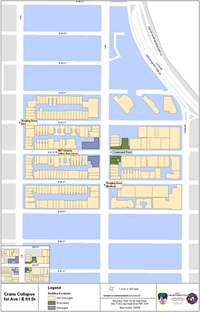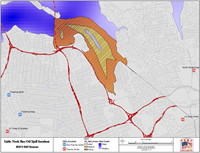ArcNews Online
Fall 2010
[an error occurred while processing this directive]High-Tech Web Mapping Helps City of New York's Fire Department Before Emergencies
Ready at a Moment's Notice
Highlights
- GIS brings together datasets to create a single map for the department's special event deployment and aids in interagency coordination.
- GIS helps build preplan maps for dispersal of personnel and equipment during city events.
- ArcGIS gives senior staff the ability to use large volumes of building, staff, and equipment data.
Everything about the Big Apple is big.
The Fire Department City of New York (FDNY) is recognized as one of the largest and most respected public safety organizations in the United States. It serves the nation's largest city. It also employs numerous staff and resources. Nearly 15,000 people serve the department-approximately 11,000 firefighters; 2,800 emergency medical technicians, paramedics, and officers; 171 fire marshals; 247 fire inspectors; 174 dispatchers; and about 1,100 administrative support personnel. There are 341 engine and ladder companies, 359 ambulances, and another 65 specialty apparatus consisting of units trained in hazardous materials response.
Recently, FDNY has been reevaluating response procedures to large-scale incidents. With thousands of personnel operating hundreds of apparatus, FDNY's assignment of resources to major emergencies is complex. In addition to natural disasters, New York City, often referred to as "the World's City," is a target for terrorism. FDNY is always looking to improve how it prepares for both man-made and natural incidents. GIS is helping in this mission.
"We've been using GIS information and delivery processes to support new response procedures," says Captain Steven Pollackov, GIS commanding officer, FDNY. "Our goal is to provide a common operating picture. Better decisions can be made using that."
In a few short years, the FDNY GIS Unit has created a comprehensive geodatabase, developed an enterprise server environment, implemented a Flex API Web viewer, and created effective data sharing among New York City's different GIS units.
The FDNY GIS Unit
Pollackov commands the FDNY GIS Unit, operating from the agency's headquarters, which also houses the agency's operations center in Brooklyn, New York. The unit performs numerous duties, including the following:
- Obtain and maintain up-to-date information on assets and infrastructure.
- Develop and implement data specific to FDNY needs.
- Provide customized mapping, analysis, and reporting solutions to support FDNY emergency responders of all ranks.
- Research, promote, and support the use of GIS technology.
- Liaison with local, state, and federal GIS organizations.
In 2009, fire apparatus responded to 432,969 fires and other nonfire emergencies. Emergency medical services personnel responded to 1.3 million medical emergencies. These amount to more than 3,000 calls a day. GIS maps and analysis, whether for preparing for major events or planning for daily work, help FDNY do a better job.

Special events handled by FDNY are posted so the operations center and all staff chiefs have access to the resources dedicated to the event. This Web map displays the 2010 Times Square New Year's Eve celebration.
"We make maps to support the department's requirements," says Pollackov. "We responded to more than a 1,000 requests last year. But we also have available a Flex Web map viewer that our chiefs and operations staff can use. They can point and click to see what they need when they need it."
With ArcGIS as the technology that best suited FDNY's multitudinous needs, the department's ArcGIS enterprise implementation grew so it now stores all types of data, including apparatus locations, administrative boundaries, streets, incidents, building footprints, hydrants, standpipes, and hospital resources.
The GIS Unit creates and maintains high-quality GIS data that adheres to the uniform standards of New York City to ensure that data sharing among agencies is similar to other agencies' data requirements. It disseminates its GIS work/applications to all FDNY bureaus.
At the operations center, GIS maps and the data-rich Flex Web application give senior staff the ability to utilize large volumes of building, staff, and equipment data using the map as the entry point of a common operational picture for situational awareness. Everyone is looking at the same data using the Web application. If a major incident occurs and additional resources are needed, several different staff members have both a macro-level view of the city and fire service and a detailed view of a particular incident. Yet, for each staff member looking at maps at different scales, it's still all based on the same data. In years past, getting the information to the operations center might have included desktop software, paper maps, and databases in separate locations and maintained by different agencies.
"It's a shared GIS resource for FDNY," says Pollackov. "We're here to help our firefighters and emergency medical staff."
Mapping to Solve All Types of Challenges
GIS is used for all New York City's major special events, such as the New Year's Eve Times Square celebration, St. Patrick's Day parade, 4th of July fireworks event, and Macy's Thanksgiving Day parade; each requires months of planning. The FDNY GIS Unit uses ArcGIS to bring together various datasets to create a single map for the department's special event deployment and aid in interagency coordination. GIS helps build preplan maps that incident commanders then utilize to plan where to place personnel and equipment to maintain situational awareness during the actual event. The Web map application allows the operations center to view maps of the current special event deployment. The New Year's Eve celebration draws one million attendees, and FDNY provides 15 EMS units and four hazmat teams for the event. The last event was relatively calm: 150 people were treated for injuries. GIS helped view where fire and medical branch teams were located so that, should a major incident occur, the city would be ready.

This crane collapse occurred in NYC on May 30, 2008. GIS was performed to support our Incident Commander and Incident Management team on scene of the crane collapse.
FDNY operates approximately 21,000 alarm boxes throughout New York City. Every address is associated with an alarm box for dispatch purposes. The FDNY GIS knows the location of and what type of apparatus response is required to respond to each alarm box, depending on the type or zoning of the building. A response analysis can be performed to ensure that proper coverage is available for that building should the alarm box activate. Various numbers of responding staff and apparatus are dispatched depending on the nature of the incident.
"We are able see alarm boxes and easily correlate which engine and ladder units are available for a response," says Pollackov. "We can see, for example, that Engine 10 and Ladder 10 respond to these areas, and those are their first-due areas. Understanding the areas and coverage is obviously very important. GIS helps us here."
Response time maps are utilized to evaluate the existing locations of the department's ambulances. The maps display response times and indicates how often a paramedic ambulance responds to a high-priority assignment.
Recently, the FDNY GIS Unit has expanded the use of ArcGIS with its analysis capabilities. For example, all major fires from 1997 through 2009, which comprised 38,498 incidents, were mapped, and hot spots were generated. Further analysis broke down these hot spots by various temporal segments (year, month, day, and hour). Staff chiefs can use this information to identify areas with a high volume of fire incidents. They can then make informed decisions about possibly adding a fire company and/or justify why it would be detrimental to close a fire company, which is a realistic possibility given that fire agencies are being forced to reduce budgets. In addition, during a recent Incident Management Team (IMT) drill, GIS and maps assisted the planning chiefs in visualizing the event to make informed decisions, resulting in more effective management of the incident.
The FDNY operations center can now access and view simultaneously automatic vehicle location (AVL); subway blueprints; oblique angle aerial photography; street-level imagery; and outside map services, such as weather and traffic data. The FDNY GIS Unit is planning to incorporate all these GIS applications into a single common operational platform through the Web map application.
"Our next main objective is to get GIS down to the incident commander," says Pollackov. "Currently, our incident commanders only receive GIS maps during large-scale incidents, when the Incident Management Team is activated. Our goal is for our incident commanders to be able to view maps en route to an incident. This and other goals have significant challenges that the FDNY GIS Unit is attempting to accomplish in the near future."
More Information
For more information, contact Steven Pollackov, captain/GIS commanding officer, GIS Unit, Fire Department City of New York (e-mail: pollacks@fdny.nyc.gov).
